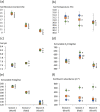Natural farming improves crop yield in SE India when compared to conventional or organic systems by enhancing soil quality
- PMID: 36974061
- PMCID: PMC10035491
- DOI: 10.1007/s13593-023-00884-x
Natural farming improves crop yield in SE India when compared to conventional or organic systems by enhancing soil quality
Abstract
Zero Budget Natural Farming (ZBNF) is a grassroot agrarian movement and a state backed extension in Andhra Pradesh, and has been claimed to potentially meet the twin goals of global food security and environmental conservation. However, there is a lack of statistically evaluated data to support assertions of yield benefits of ZBNF compared to organic or conventional alternatives, or to mechanistically account for them. In order to fill this gap, controlled field experiments were established in twenty-eight farms across six districts, spanning over 800 km, over three cropping seasons. In these experiments, we compared ZBNF (no synthetic pesticides or fertilisers, home-made inputs comprising desi cow dung and urine with mulch) to conventional (synthetic fertilisers and pesticides) and organic (no synthetic pesticides or fertilisers, no mulch, purchased organic inputs, e.g. farmyard manure and vermicompost) treatments, all with no tillage. Comparisons were made in terms of yield, soil pH, temperature, moisture content, nutrient content and earthworm abundance. Our data shows that yield was significantly higher in the ZBNF treatment (z score = 0.58 ± 0.08), than the organic (z= -0.34 ± 0.06) or conventional (-0.24 ± 0.07) treatment when all farm experiments were analysed together. However, the efficacy of the ZBNF treatment was context specific and varied according to district and the crop in question. The ZBNF yield benefit is likely attributed to mulching, generating a cooler soil, with a higher moisture content and a larger earthworm population. There were no significant differences between ZBNF and the conventional treatment in the majority of nutrients. This is a particularly important observation, as intensive use of synthetic pesticides and fertilisers comes with a number of associated risks to farmers' finances, human health, greenhouse gas emissions, biodiversity loss and environmental pollution. However, long-term field and landscape scale trials are needed to corroborate these initial observations.
Supplementary information: The online version contains supplementary material available at 10.1007/s13593-023-00884-x.
Keywords: Conventional agriculture; Organic farming; ZBNF; Zero budget natural farming.
© The Author(s) 2023.
Conflict of interest statement
Conflict of interestRySS is responsible for promotion of ZBNF across Andhra Pradesh.
Figures



References
-
- Agoramoorthy G. Can India meet the increasing food demand by 2020? Futures. 2008;40:503–506. doi: 10.1016/j.futures.2007.10.008. - DOI
-
- Al-Maliki S, Al-Taey DKA, Al-Mammori HZ. Earthworms and eco-consequences: considerations to soil biological indicators and plant function: A review. Acta Ecol Sin. 2021;41:512–523. doi: 10.1016/j.chnaes.2021.02.003. - DOI
-
- Bharucha ZP, Mitjans SB, Pretty J. Towards redesign at scale through zero budget natural farming in Andhra Pradesh, India. Int J Agric Sustain. 2020;18:1–20. doi: 10.1080/14735903.2019.1694465. - DOI
-
- Bhattacharya N. Food sovereignty and agro-ecology in Karnataka: interplay of discourses, identities, and practices. Dev Pract. 2017;27:544–554. doi: 10.1080/09614524.2017.1305328. - DOI
-
- Bhattacharyya R, Ghosh BN, Mishra PK, et al. Soil degradation in India: challenges and potential solutions. Sustainability (Switzerland) 2015;7:3528–3570. doi: 10.3390/su7043528. - DOI
LinkOut - more resources
Full Text Sources
Miscellaneous
